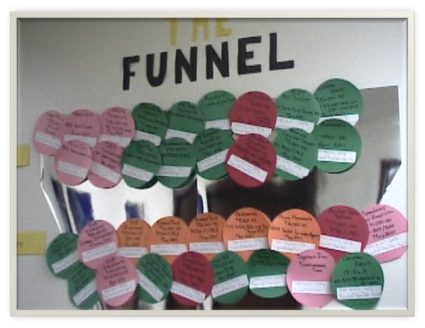Our thinking and visualizations of our sales processes, deal strategies, funnels, and pipelines often cause us to do the wrong things. It’s because we have a “one way street” mentality as we think of our deal strategies. Things progress–top to bottom, left to right (or right to left in certain parts of the world).
We prospect, qualify, discover, demonstrate, propose, close, implement.
Everything moves in one direction, we’re always moving forward—-except when we don’t.
The other day, I was reviewing a critical deal. You guessed it, it was large and critical to the quarter end. The sales person had it moving from the proposing to closing stages of their sales process, but the deal had been stalled for some months. The sales person was insistent that it would close when projected.
In reviewing the deal, the sales person had been using the sales process. She’d been working on the deal for about 6 months, was executing the process step by step moving it through the stages until it reached it’s current point and it stopped. She was trying to move it forward, but it just wasn’t working.
As we examined things, we started seeing:
There had been a major management restructuring, with new management a couple of levels above the decision-maker. A shift in corporate priorities, other projects were being cancelled.
I asked, “Is the deal still a priority, is it a real deal? Should we requalify it? Given all the changes just above the decision-maker, do we need to reassess the whole thing? Should this be in the closing stages of our pipeline?”
That’s when I started seeing the nervous glances among the team. They had worked hard to get the deal to this place. They needed to close the deal. They tried hard to argue, “We’ve followed our sales process, we’ve done everything we need to do to get it to the closing stage of the process. So we just need to push it forward.” They were trying as hard as they could to push the deal through, but it just wasn’t happening.
We agreed they would go back and explore the urgency of the deal with the customer, particularly given the changes. They also found a way to meet with some of the new corporate executives.
They learned, there was some interest in the project, but it wasn’t a high priority and the funding for the project was being diverted. With some of the shifts in the corporate strategies, the needs and requirements for this project were changing. The good news was they were changing in a way that made the deal both bigger and made my client a much better fit.
As we examined all the information the team had gotten, we realized we needed to start the sales process all over again. While much of the work they had done would probably be very valuable, things had changed.
The team needed to requalify the deal, then go through all the sales process again. All based on the changes that had occurred within the customer.
While the team intuitively knew all of this, they were blinded thinking things only go one way in the pipeline or in our sales process. We always move forward.
Ideally, we do, but the sales process and the pipeline is a two way street. Sometimes things go back to the beginning of the sales process, sometimes they pop back to the top of the funnel.
Not recognizing this means we are fooling ourselves and our managers in the expectations we set in our pipelines. Not recognizing this means we are not aligned with the customer and where they are with their buying process. As a result, we aren’t creating the value we should–in fact may be doing all the wrong things.
The team moved the deal back to the top of the pipeline. They changed the projected close date–actually they left it open, since they needed to requalify the whole deal. They started developing strategies to start the whole process all over again. While it was disappointing, with out doing this, they would have continued doing the wrong things with the customer and setting the wrong expectations for their own management. They would have been wasting their and everyone else’s time.
We all have deals like that. Deals we’ve worked hard on. We’ve brought them to a certain place, but they stop. Things change, we need to reassess, restart and go through our process yet again. Perhaps we are a little smarter from having gone through it once before. Perhaps we can accelerate the buying process, based on that knowledge, but we have to go back requalify, rediscover, redemonstrate, repropose and close again on the “new deal.”
Don’t think of your sales process or pipeline as a one way street. Things can and should move backwards. Denying it, doesn’t help anything.

Excellent post, Dave!
I couldn’t agree more. Problem solving and buying happens so often in iterations…for many different reasons, as you explained perfectly.
A few thoughts here:
http://blog.tamaraschenk.com/?p=1957
Thanks Tamara, great post!